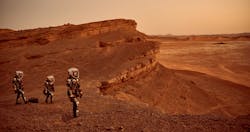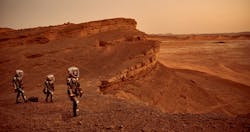This file type includes high resolution graphics and schematics when applicable.
To date, the only Earth-based entities on Mars have been robots. NASA is still planning on sending people to Mars sometime around 2030 and is actively developing technologies to make that possible.
SpaceX CEO Elon Musk has his own plans for Mars. SpaceX has been on the forefront of reusable rockets working with NASA, and SpaceX’s Dragon capsule has already delivered material to the International Space Station.
National Geographic Channel's Mars series examines how we might begin to live on Mars and the challenges that explorers will need to face far from Earth.
The popularity of movies like The Martian have peaked interest in putting earthlings on Mars. The National Geographic Channel’s new “Mars” television series debuts this month brought to you by producers Ron Howard (Apollo 13) and Brain Grazer (A Beautiful Mind). Like The Martian, the “Mars” series will be fiction based in real-world technology, but with more of a twist on technology other than just being technically correct when it is used by the actors. Viewers will get to see the actors as well as vignettes of NASA researchers as they watch the series. This will show both the practicality of going to Mars as well as the challenges and potential solutions that are in the mix. Also, The Martian was more of a survival story while the series looks at how Mars might be settled for long-term habitation.
I talked with Dr. Robert D. Braun, Professor of Space Technology, Georgia Institute of Technology, about the series on which he consulted with its writers. Dr. Braun has been intimately involved with NASA and Mars-related projects for many years.
The characteristics of Mars are somewhat different than Earth. For example, wind speeds are higher on Mars, but the dynamic pressure of the wind is lower because the air density is lower. Tornado-like sand storms can cause problems, but they are not necessarily as robust as in the movie.
One of the most challenging areas for this type of exploration will be shielding and redundancy. The electronics used in space are more advanced than in the past, but not on par with what we are used to with computers and smartphones. Single-event upsets (SEUs) are more common with particle shielding like Earth’s atmosphere and magnetosphere. One area of research is in active shielding using superconducting magnets.
I recently hosted a webinar, Challenges for Electronic Circuits in Space Applications, with Analog Devices and EBV Elektronik in which we talked about the challenges of electronics in space applications. Rugged terrestrial electronics are improving, but those designed specifically for space are needed for Mars.
Even the dirt on Mars will be an issue. It is a fine regolith found with properties significantly different compared to terrestrial soil—growing potatoes, as in The Martian, notwithstanding.
Dealing with catastrophes, shortages, and people will be just a few of the issues actors will have to deal with. In the meantime, NASA will be working to develop the technology and logistics to make it actually happen.
This file type includes high resolution graphics and schematics when applicable.
About the Author
William Wong Blog
Senior Content Director
Bill's latest articles are listed on this author page, William G. Wong.
Bill Wong covers Digital, Embedded, Systems and Software topics at Electronic Design. He writes a number of columns, including Lab Bench and alt.embedded, plus Bill's Workbench hands-on column. Bill is a Georgia Tech alumni with a B.S in Electrical Engineering and a master's degree in computer science for Rutgers, The State University of New Jersey.
He has written a dozen books and was the first Director of PC Labs at PC Magazine. He has worked in the computer and publication industry for almost 40 years and has been with Electronic Design since 2000. He helps run the Mercer Science and Engineering Fair in Mercer County, NJ.
- Check out more articles by Bill Wong on Electronic Design
- Bill Wong on Facebook
- @AltEmbedded on Twitter



